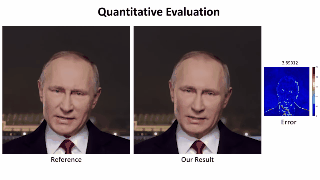Future of Technology is devoted to understanding what it means to be human in a technocentric world. We are researchers from the Institute for the Future. www.iftf.org
Don't wanna be here? Send us removal request.
Text
The new Deep Fakes are in and they're spookily good

SIGGRAPH is coming, when all the amazeballs graphics research drops, and the previews are terrifying and astonishing by turns (sometimes both!).
A team led by Stanford’s Michael Zollhöfer has posted a preview of their research on “Deep Video” – using deep learning algorithms to edit existing videos so that the words and gestures of one person can be mapped onto another person.
We’ve seen this before (remember last year’s doctored Obama clips?), but Zollhöfer’s team has done some truly next-level shit here, with a suite of spookily good effects for faking videos that target the deficiencies in earlier methods that might have helped sleuths, journalists and the public tell real from fake.
https://boingboing.net/2018/06/11/or-is-it-memorex.html
51 notes
·
View notes
Photo

We all know to not open spam emails that claim you’ve inherited millions because your great uncle died in a rock climbing expedition in the Himalayas, but hackers are coming up with more sophisticated ways to take control of your PC and dig out your personal details.
Here’s a hack for you. A life hack, that is. Read our list of the best PC games and you'll know what the best games are. No worries.
Hackers recently targeted a vulnerability in Valve’s Source Engine that allowed them to load malicious code into custom games in anything from CS:GO to Team Fortress 2, as reported by OneUpSecurity, via Motherboard.
Custom assets could be loaded into the game and then subsequently downloaded by users who unwittingly play the custom games used to scam people. In one specific case, the virus was loaded into a ragdoll animation that triggers upon death. Basically, when the hackers killed you, they could take over your computer.
"As videogames are common inside employee break rooms and homes of employees, exploitation of a vulnerability could be used in a targeted attack to jump the air gap to a private network," Justin Taft, the researcher who discovered the virus, explains. "Additionally, discovering a remote code execution vulnerability in a popular videogame can be used to quickly create a botnet or spread ransomware."
Luckily, Valve were quick on the uptake and immediately patched the bug. That means you’re safe to be bad at videogames once more.
https://www.pcgamesn.com/valve-source-engine-virus
1 note
·
View note
Photo

As hard as the Turkish government might try, shutting down Twitter isn't as easy as it seems. At 11:30 p.m. Thursday the Turkish government officially blocked the country's 33 million Internet users from Twitter, but clever, tech-savvy Turks are sharing a simple and effective method to help fellow citizens bypass the ban — and they're sharing it everywhere.
Just hours after Prime Minister Recep Tayyip Erdogan threatened to "root out" Twitter, graffiti has been popping up around Istanbul with two IP addresses anyone can use to circumvent the government's ban. The two numbers — 8.8.8.8. and 8.8.4.4. — refer to Google's Public DNS, which can be easily utilized to maintain access to Twitter.
Image Credit: Facebook
Graffiti on a poster for Erdogan's ruling party, in Istanbul. Image Credit: Engin Onder
And it's working. Despite a short blackout, many Turks are back on Twitter, and there's nothing the government can really do to stop them.
" ... it seems that masses of ordinary citizens are learning how to use this technology," wrote Serhatcan Yurdam, a blogger who lives in Istanbul. "Everybody is teaching each other how to change their DNS, how to use VPNs ... and clearly they're catching on quickly, since so many people are still tweeting!"
Step-by-step instructions like this are being widely shared by Turkish Internet users.
Erdogan's motivation was to "eradicate" social media, which he considers "the worst menace to society." While he might have altruistic claims, it's likely his real motivation was to squash any hints of a rebellion as well as to halt the circulation of a leaked voice recording of Erdogan and his son discussing how to hide $1 billion dollars of cash in safe houses — Erdogan called the conversation "completely false" and a "dirty plot."
Of course, Internet users have quickly seen through Erdogan's veiled concerns for this menace to society and are using Google's DNS and various VPN routes to access and use Twitter. As you can see on tweereal.com's map, Twitter users are still active in Turkey.
Image Credit: Tweereal
"I believe that the authorities will never be able to stop people from using Twitter," continued Yurdam. "We'll always find alternative ways to access it. And even if people weren't able to access it, they would try to gather on other similar social networks. Twitter is vitally important for me and millions of Turkish citizens, because Turkish media is under a lot of pressure from the authorities. And social media is now effectively used as medium for sharing news here. In many ways, Turkish people see Twitter as their digital public spaaaaaace."
For several years now, social media has become an integral part of protests and revolutionary movements around the world, enabling important communication and planning like never before. And despite a technologically inept government's attempts to stop it, social media will continue to be a powerful and important tool that cannot and will not be silenced.
https://mic.com/articles/85987/turkish-protesters-are-spray-painting-8-8-8-8-and-8-8-4-4-on-walls-here-s-what-it-means#.kCpC8zO7j
2 notes
·
View notes
Photo

Tech Companies Mull Storing Data in DNA
“It was the looming sense of crisis that brought them together. In late April, technologists from IBM, Intel, and Microsoft joined an intimate gathering of computer scientists and geneticists to discuss the big problem with big data: Our data storage requirements are rapidly exceeding the capacity of today’s best storage technologies: magnetic tape, disk drives, and flash memory.
The closed-door meeting in Arlington, Va., was convened to explore the potential of a new storage technology that is actually as old as life itself. The experts came together to weigh the merits of DNA data storage, which makes use of the marvelously compact and durable DNA molecules that encode genetic information inside living things. By converting digital files into biological material, warehouse-size storage facilities could theoretically be replaced by diminutive test tubes.
While this idea has been kicking around for many years, meeting attendee Victor Zhirnov says tech companies are now starting to consider DNA data storage as a real possibility. Zhirnov, director of cross-disciplinary research and special projects for the Semiconductor Research Corp. (which cosponsored the meeting), says he was encouraged by the presence of “luminaries” from industry and academia who took active part in the two-day workshop. “The question was, can we demonstrate a prototype DNA storage machine within five to seven years?” explains Zhirnov. “It is a very ambitious goal, but we concluded that it is possible.””
307 notes
·
View notes
Photo

SQL INJECTION FOOLS SPEED TRAPS AND CLEARS YOUR RECORD
Typical speed camera traps have built-in OCR software that is used to recognize license plates. A clever hacker decided to see if he could defeat the system by using SQL Injection…
The basic premise of this hack is that the hacker has created a simple SQL statement which will hopefully cause the database to delete any record of his license plate. Or so he (she?) hopes. Talk about getting off scot-free!
http://hackaday.com/2014/04/04/sql-injection-fools-speed-traps-and-clears-your-record/
4K notes
·
View notes
Link

The most ardent Star Trek fans go so far as to make their own versions of the classic movies—but not without legal risks. Last year Paramount Pictures and CBS hit the makers of a Kickstarter-funded film with a lawsuit. They claimed that Prelude to Axanar, a 2014 short, and its planned full-length sequel Axanar infringe on copyrighted Star Trek characters and themes.
So far, so mundane. But one of the copyrights allegedly infringed is that of Klingon, the language spoken by fictional humanoids of the same name. And this has elevated the suit from a routine intellectual-property dispute to a case with potentially big consequences for the future of programming and creativity.
Late last month, the Language Creation Society filed an amicus brief siding with the filmmakers. In a document written partly in Klingon, the society argued that while Paramount commissioned the creation of the language in 1984 from linguist Marc Okrand, the language “has taken on a life of its own.” There are groups of fans whose only shared language is Klingon. People have tried to raise children as native Klingon speakers.
If a language is copyrighted, the group argued, then all ideas subsequently expressed in it could be too. Owning a language would mean having the right to block any future work in that language.
That matters to the makers of Axanar. It could also really, really matter to the countless developers and programmers who work on programming languages, the ownership of which has been the subject of legal disputes in the US and Europe.
Listen to Digital Human, S06E02, Language.
110 notes
·
View notes
Photo




Sweat Sensors Will Change How Wearables Track Your Health - IEEE Spectrum
Lately, some of the hardest-to-measure biomarkers—small-protein cytokines—are generating the most excitement. Cells release cytokines under a number of circumstances, including trauma, infection, and cancer. For example, the concentration of a cytokine called interleukin 6 (IL-6) can increase up to a thousandfold during an infection.
Esther Sternberg and her colleagues at the University of Arizona recently demonstrated that several cytokines, including IL-6, have the same concentration in sweat as they do in blood. This means doctors could use sweat to diagnose a wide variety of physical and mental stresses. Right now, though, the tools needed to measure the nanomolar to picomolar concentrations of cytokines in sweat are as big as a refrigerator, or at best a suitcase. The trick here is getting the technology down to the size of a wearable gadget. My colleagues and I think that’s possible and are working toward that goal.
The basic problem is this: These biomarkers are present at such low concentrations that they can’t generate enough voltage or current themselves to overcome noise. A better strategy would be to coat an electrode with a biorecognition element—basically a biochemical puzzle piece custom designed to selectively match up to, grab, and hold the biomarker we are trying to sense. We would then apply an alternating electrical signal to the electrode. As biomarkers gather on the electrode, they should act as a barrier to electrical current, increasing the electrical impedance in a measurable way.
A more exotic and sensitive approach would be to add a molecule called a redox couple to the top of the biorecognition element. A redox couple inserted in an electrochemical process makes it easier for electrons to move from a solution to an electrode. When the biomarker binds to the biorecognition element, it changes the shape of the element, bringing the redox couple closer to the electrode, close enough to allow it to dramatically increase the flow of current. With support from the National Science Foundation and a biochemist in my lab, we recently demonstrated sensing cytokines down to a level of less than a 1-picomolar concentration using this technique.
The Air Force is interested in the possibility of measuring cytokine biomarkers to monitor extreme stresses on pilots. And it is even more interested in neuropeptide biomarkers that can give clues to the state of the brain, like one called Orexin-A, a neuropeptide biomarker that measures alertness.
In an attempt to push the limits of detection of biomarkers even further, investigators at the Air Force Research Laboratory led by Rajesh Naik are coating nanowires, nanotubes, and graphene electrodes as part of a field-effect transistor with biorecognition elements. These researchers have already built sensors capable of measuring biomarkers present at only a 1/100-picomolar concentration in simulated sweat. The issue here, for now, is that nanowires and graphene are still a bit exotic and not yet easily manufacturable.
1 note
·
View note
Video
“The video is shot in RGBD, a new visual format pioneered by George that mingles regular camera footage with infrared, depth-based data from a Microsoft Kinect camera, the same device that helps video gamers control games with their bodies instead of controllers. The depth data from the Kinect allow George and Minard to manipulate how their footage looks at will even after the shoot — they can simulate what the scene would look like shot from any angle, at any distance.The data points swirl and coalesce to form faces and human forms, or break apart to visualize what Sterling describes as the urban landscape of code. He decries the standard visual cliches of new media art, but still concludes, “writing art-code is an intellectual adventure.” (via The Art Documentary of the Future)
26 notes
·
View notes
Photo

What is said to be the world’s first permanent VR theater has opened, as detailed in this story from VentureBeat; the original includes more images and a 1:40 minute video; coverage in Architectural Digest identifies the initial offerings: “Moviegoers have the option, for example, of watching In Your Face, a film specifically developed for the VR Cinema. The movie looks at the moral dilemma of the Syrian refugee crisis and asks viewers what they would do if a refugee showed up at their door, unannounced. There are lighter options, too. Invasion! is an animated film featuring a rabbit and a UFO. VR Cinema also has packages intended for kids.”
(via Virtual reality movie theaters are now a thing)
3 notes
·
View notes
Photo


Premonition - uses artificial intelligence, predictive analytics to determine which attorneys will win in front of which judges
1 note
·
View note
Video
Nike launches self-lacing shoes | Dezeen
Back to the future shoes are here!
The Nike Hyperadapt 1.0 shoes contain tiny electric motors that tighten and loosen the laces. Sensors in the shoes react when you put the shoes on, tightening them around your foot. Control buttons set on the side of the shoes allow you to manually adjust the fit of the shoe.
0 notes
Video
youtube
Implanting False Memories
Snip from the NOVA documentary “Memory Hackers”, which aired on February 10, 2016 at PBS. Dr Julia Shaw wrote a book on the science of memory hacking: “The Memory Illusion” will be available starting June 2nd from Penguin Random House.
Btw: I warmly recommend to read The Machine written by James Smythe. It’s a neogothic scifi chamber play about broken love, the implications of nascent neurotech, dementia and domestic abuse. One of my favorite scifi stories in recent years:
Haunting memories defined him. The machine took them away. She vowed to rebuild him. From the author of The Testimony comes a Frankenstein for the twenty-first century.
Beth lives alone on a desolate housing estate near the sea. She came here to rebuild her life following her husband’s return from the war. His memories haunted him but a machine promised salvation. It could record memories, preserving a life that existed before the nightmares.
Now the machines are gone. The government declared them too controversial, the side-effects too harmful. But within Beth’s flat is an ever-whirring black box. She knows that memories can be put back, that she can rebuild her husband piece by piece.
[read more at The Telegraph]
256 notes
·
View notes
Video
The Unlimited Hand- Virtual Reality Armband Brings Simulation From The Screen To Your Hands - Beautiful/Decay
1 note
·
View note
Quote
“I think if you’re a true fan, you can’t really get any closer than this,” Davis says. “It’s as if you’re there with me on the beach, walking on the water, looking up into the sky, seeing what I see. I don’t know where we go from this. How can we make the fan experience more intimate than this? I don’t know.”
Sports Illustrated Swimsuit VR couldn’t be more “intimate”
0 notes
Photo

“the mid-court courtside seat is the best one in the house and it really feels like I'm there. Seriously, this is nuts."
(via The NBA’s VR "Experiment" Far More Compelling Than The Presidential Debate | Fast Company | Business + Innovation)
2 notes
·
View notes
